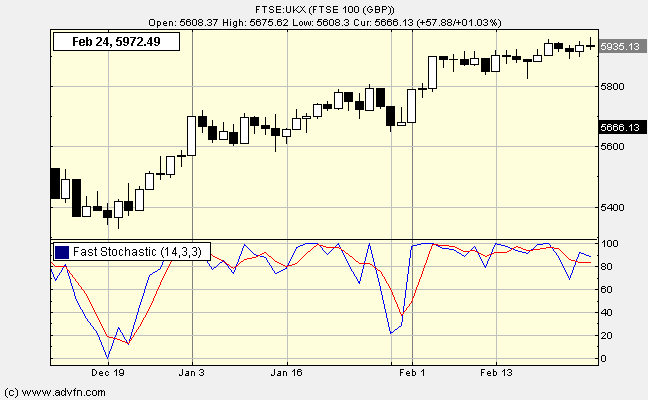Overbought/Oversold Indicators 1
“Overbought” and “oversold” are words without precise definition. Nevertheless their connotations are clear enough. Even poorly-managed, heavily indebted or loss-making company can become oversold and too cheap and therefore worth buying. On the other hand even well-managed companies like Apple or Google can at some point become overhyped, overheated and overvalued. Both terms suggest that price has reached an extreme and imply the promise of an imminent turn. No wonder that various overbought/oversold (OBOS) indicators have become so popular!
Unfortunately, many traders use indicators in isolation, when proper use requires that they be considered within a larger technical context. In a later lesson we will take up the proper use of OBOS indicators. In this and the next lesson, we will review the logic of several different indicators and build a single indicator which combines the best of each.
The earliest, and arguably still the best, method for gauging whether an issue is OBOS is the simple trendline. When trendlines are broken, either with the trend (climactic shakeout) or against the trend (counter-trend shakeout), a stock or commodity is OBOS relative to that trend (see Trendlines 1 & Trendlines 2).
RSI
There are three other methods commonly used to indicate OBOS. The first of these is the Relative Strength Indicator, or RSI. Over some period, say 20 days (one could as well use any other period–hour, week, month, etc–depending on focus), RSI compares the sum of daily gains with the sum of daily losses.
Suppose that an issue has moved up for eight out of the last twenty days, and that the total gain over those eight days is +4%. Assume further that the issue fell during ten of those twenty days, but that the total of those ten losses is -4%. On two days there was no change.
To calculate RSI, begin by determining the ratio of gains to losses. The resultant ratio must be a positive number. This may be accomplished by changing the sign of the sum of losses, as in this formula for the ratio:
![]()
The rest of the RSI formula is given below:
![]()
Since the ratio of total gain to total loss equals 1 (+4/-(-4)), substituting this result in the above formula yields:
![]()
or 50.
RSI is calculated to range from zero (maximum oversold reading) to 100 (maximum overbought). If there are only losses during the look-back period, then RSI will register zero; if there are only gains, the RSI will indicate 100. In the example above, a total gain of +4% is compared to a total loss of -4%. With total gain and loss even, RSI is midway between its two possible extremes, or 50. In that case, the issue is neither overbought nor oversold.
Readings of 30 or below are generally considered oversold, while readings of 70 or more indicate overbought.
The idea behind RSI is simple yet insightful. When enthusiasm for a stock peaks, positive days are likely to overwhelm negative days, in which case the RSI will approach 100. The reverse is true during periods of accelerated selling.
Any period may be chosen over which to calculate the RSI. The longer the period chosen, the longer-term the implications of the RSI reading. For short-term indications, a twenty-day RSI is best in most cases. A forty-to-sixty-day RSI picks up intermediate OBOS conditions.
Stochastic
Stochastic locates the present price within a recent trading range. Suppose that over the last 40 days an issue reached a low of 40 and a high of 60. If the stock now trades at 50, it is midway between the recent high and low of the range. Under this method, a stock trading near the low of its recent range is oversold, but overbought if near the high of the range. Where “Last” is the last price and “Minimum” and “Maximum” are the lowest and highest prices recorded over some period, the formula for Stochastic is:
![]()
Stochastic readings range from zero to 100. OBOS readings are considered the same as for RSI: 30 or less is oversold, while 70 or more is overbought.
The idea behind Stochastic appears reasonable enough, but in practice the method presents the trader with a serious problem. When a stock is rising into new high ground, it becomes, by this method, overbought and subject to sale. But as we have seen (The Nature of Strength-Following Markets) very strong stocks, those making new highs, are often the best buy.
Strong stocks can become chronically “overbought”. Traders who rely on Stochastic are likely to avoid the best purchase candidates during strength-following markets and to sell strongly trending stocks far too early. The mirror-image of this problem besets traders who use Stochastic to trigger the purchase of very weak, but “oversold”, stocks.
Note: I have learnt from my experience that overbought and oversold are just as likely to be the start of a minor up or down trend just as much as they signal a reversal. The reversal is more likely to come from a ranging market but we all know that sooner or later that range will break out and the overbought or oversold will give a start of new trend signal instead of the reversal. The chart of the FTSE at the start of the year shows stochastic giving a good buy reversal signal followed by repeated failed sell signals:

This flaw shows up in all overbought/oversold indicators unless you curve fit the settings to make the indicator work for any particular chart. It’s the reason why there will always be someone on the other side of the trade. One man’s overbought is another man’s start of trend, a swing traders buy is a growth traders sell and a value traders buy is a signal for the masses to leave the markets.


Join the discussion